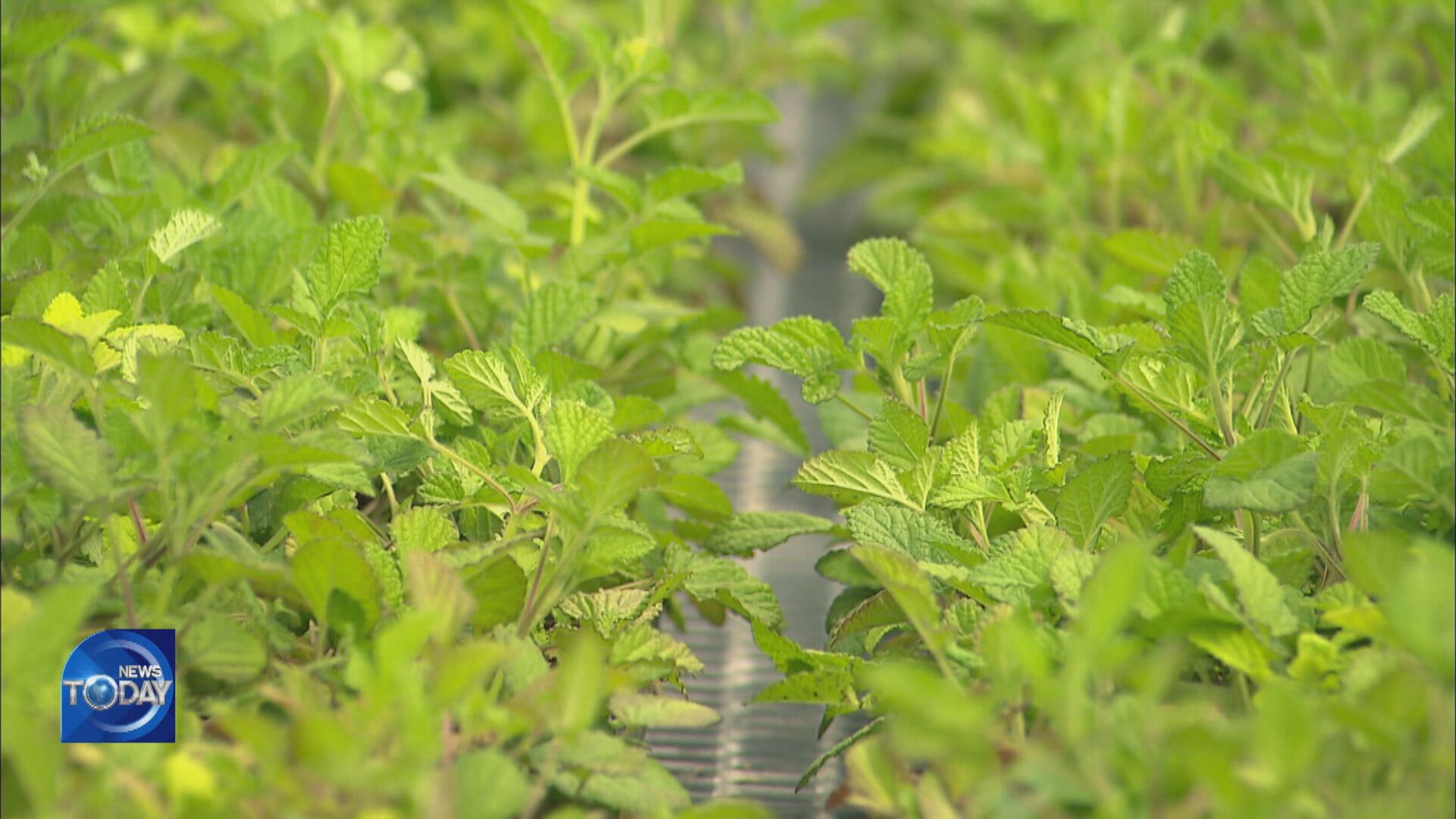DEVELOPING DOMESTIC HERBAL INGREDIENTS
입력 2021.05.17 (15:17)
수정 2021.05.17 (16:46)
읽어주기 기능은 크롬기반의
브라우저에서만 사용하실 수 있습니다.
[Anchor Lead]
Key ingredients used in traditional energy-boosting drinks or health supplements are largely imported. But now the Foundation of Agricultural Technology Commercialization and Transfer under the Rural Development Administration is attempting to procure those herbal ingredients locally. It remains to be seen whether this effort can achieve the dual goals of securing locally produced herbal ingredients and increasing farm incomes.
[Pkg]
Dansam or red sage, used in many health supplement products, is growing inside this greenhouse. Dansam falls under the same category as 4 other herbs including ginseng and the shrubby sophora. It is known to be very effective in lowering blood pressure and improving liver function. But there are growing complaints over its inconsistent quality as 91% of the domestic red sage consumption depends on imports.
[Soundbite] Yu Eun-jeong(Health Supplement Product Manufacturer) : "Imported ingredients cannot be trusted. Their quality is not consistent and we can’t find out what happened during distribution."
These farmers are busy planting dansam seedlings. The Foundation of Agricultural Technology Commercialization and Transfer has provided farmers with 90,000 seedlings of the newly developed Dasan variety. The herb will be cultivated on 1.3 hectares of land in this area. It is expected to account for 50% of Korea’s total red sage outputs.
[Soundbite] Hong Ki-pyo(Red Sage Farmer) : "I think my income from dansam will be double that of other crops. I had to find a new crop since the farming community needed a change."
Currently, 101 plants from 32 species are used for traditional herbal medicine in Korea. But as more than 70% of the plants are imported, the switch to greater reliance on locally grown produce is urgently needed.
[Soundbite] Kim Byung-woon(Foundation of Agri. Tech. Commercialization and Transfer) : "Most of the medicinal herbs are imported. We will try to develop more domestic varieties to be used for traditional medicine."
This year’s medicinal crop market in Korea is estimated to reach five trillion won. Hopefully, Korean farmers can produce herbal ingredients locally and boost their income as well.
Key ingredients used in traditional energy-boosting drinks or health supplements are largely imported. But now the Foundation of Agricultural Technology Commercialization and Transfer under the Rural Development Administration is attempting to procure those herbal ingredients locally. It remains to be seen whether this effort can achieve the dual goals of securing locally produced herbal ingredients and increasing farm incomes.
[Pkg]
Dansam or red sage, used in many health supplement products, is growing inside this greenhouse. Dansam falls under the same category as 4 other herbs including ginseng and the shrubby sophora. It is known to be very effective in lowering blood pressure and improving liver function. But there are growing complaints over its inconsistent quality as 91% of the domestic red sage consumption depends on imports.
[Soundbite] Yu Eun-jeong(Health Supplement Product Manufacturer) : "Imported ingredients cannot be trusted. Their quality is not consistent and we can’t find out what happened during distribution."
These farmers are busy planting dansam seedlings. The Foundation of Agricultural Technology Commercialization and Transfer has provided farmers with 90,000 seedlings of the newly developed Dasan variety. The herb will be cultivated on 1.3 hectares of land in this area. It is expected to account for 50% of Korea’s total red sage outputs.
[Soundbite] Hong Ki-pyo(Red Sage Farmer) : "I think my income from dansam will be double that of other crops. I had to find a new crop since the farming community needed a change."
Currently, 101 plants from 32 species are used for traditional herbal medicine in Korea. But as more than 70% of the plants are imported, the switch to greater reliance on locally grown produce is urgently needed.
[Soundbite] Kim Byung-woon(Foundation of Agri. Tech. Commercialization and Transfer) : "Most of the medicinal herbs are imported. We will try to develop more domestic varieties to be used for traditional medicine."
This year’s medicinal crop market in Korea is estimated to reach five trillion won. Hopefully, Korean farmers can produce herbal ingredients locally and boost their income as well.
■ 제보하기
▷ 카카오톡 : 'KBS제보' 검색, 채널 추가
▷ 전화 : 02-781-1234, 4444
▷ 이메일 : kbs1234@kbs.co.kr
▷ 유튜브, 네이버, 카카오에서도 KBS뉴스를 구독해주세요!
- DEVELOPING DOMESTIC HERBAL INGREDIENTS
-
- 입력 2021-05-17 15:17:18
- 수정2021-05-17 16:46:31

[Anchor Lead]
Key ingredients used in traditional energy-boosting drinks or health supplements are largely imported. But now the Foundation of Agricultural Technology Commercialization and Transfer under the Rural Development Administration is attempting to procure those herbal ingredients locally. It remains to be seen whether this effort can achieve the dual goals of securing locally produced herbal ingredients and increasing farm incomes.
[Pkg]
Dansam or red sage, used in many health supplement products, is growing inside this greenhouse. Dansam falls under the same category as 4 other herbs including ginseng and the shrubby sophora. It is known to be very effective in lowering blood pressure and improving liver function. But there are growing complaints over its inconsistent quality as 91% of the domestic red sage consumption depends on imports.
[Soundbite] Yu Eun-jeong(Health Supplement Product Manufacturer) : "Imported ingredients cannot be trusted. Their quality is not consistent and we can’t find out what happened during distribution."
These farmers are busy planting dansam seedlings. The Foundation of Agricultural Technology Commercialization and Transfer has provided farmers with 90,000 seedlings of the newly developed Dasan variety. The herb will be cultivated on 1.3 hectares of land in this area. It is expected to account for 50% of Korea’s total red sage outputs.
[Soundbite] Hong Ki-pyo(Red Sage Farmer) : "I think my income from dansam will be double that of other crops. I had to find a new crop since the farming community needed a change."
Currently, 101 plants from 32 species are used for traditional herbal medicine in Korea. But as more than 70% of the plants are imported, the switch to greater reliance on locally grown produce is urgently needed.
[Soundbite] Kim Byung-woon(Foundation of Agri. Tech. Commercialization and Transfer) : "Most of the medicinal herbs are imported. We will try to develop more domestic varieties to be used for traditional medicine."
This year’s medicinal crop market in Korea is estimated to reach five trillion won. Hopefully, Korean farmers can produce herbal ingredients locally and boost their income as well.
Key ingredients used in traditional energy-boosting drinks or health supplements are largely imported. But now the Foundation of Agricultural Technology Commercialization and Transfer under the Rural Development Administration is attempting to procure those herbal ingredients locally. It remains to be seen whether this effort can achieve the dual goals of securing locally produced herbal ingredients and increasing farm incomes.
[Pkg]
Dansam or red sage, used in many health supplement products, is growing inside this greenhouse. Dansam falls under the same category as 4 other herbs including ginseng and the shrubby sophora. It is known to be very effective in lowering blood pressure and improving liver function. But there are growing complaints over its inconsistent quality as 91% of the domestic red sage consumption depends on imports.
[Soundbite] Yu Eun-jeong(Health Supplement Product Manufacturer) : "Imported ingredients cannot be trusted. Their quality is not consistent and we can’t find out what happened during distribution."
These farmers are busy planting dansam seedlings. The Foundation of Agricultural Technology Commercialization and Transfer has provided farmers with 90,000 seedlings of the newly developed Dasan variety. The herb will be cultivated on 1.3 hectares of land in this area. It is expected to account for 50% of Korea’s total red sage outputs.
[Soundbite] Hong Ki-pyo(Red Sage Farmer) : "I think my income from dansam will be double that of other crops. I had to find a new crop since the farming community needed a change."
Currently, 101 plants from 32 species are used for traditional herbal medicine in Korea. But as more than 70% of the plants are imported, the switch to greater reliance on locally grown produce is urgently needed.
[Soundbite] Kim Byung-woon(Foundation of Agri. Tech. Commercialization and Transfer) : "Most of the medicinal herbs are imported. We will try to develop more domestic varieties to be used for traditional medicine."
This year’s medicinal crop market in Korea is estimated to reach five trillion won. Hopefully, Korean farmers can produce herbal ingredients locally and boost their income as well.
이 기사가 좋으셨다면
-
좋아요
0
-
응원해요
0
-
후속 원해요
0

















이 기사에 대한 의견을 남겨주세요.